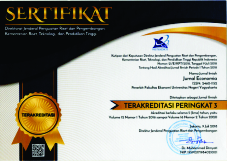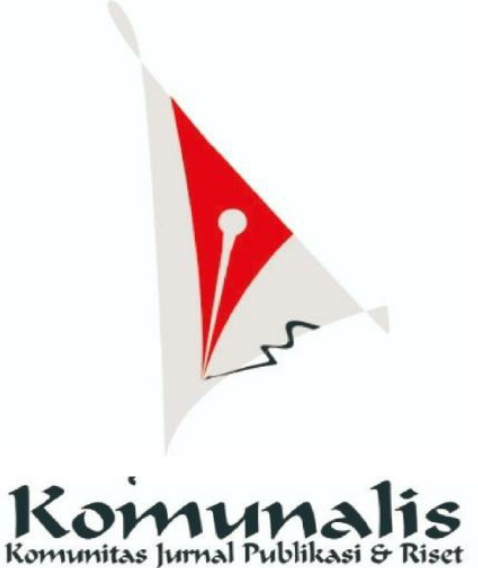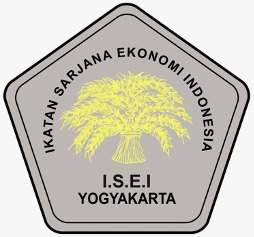A Critical Review of Digital Marketing: Effect of Flow and Impulse Buying
Downloads
Keywords: flow, willingness to buy, user belief, impulse buying behavior.
Tinjauan Kritis Pemasaran Digital: Pengaruh Flow dan Pembelian Impulsif
Abstrak: Penilitian ini bertujuan untuk menguji pengaruh kepercayaan pengguna (user belief) terhadap flow, willingness to buy terhadap flow, dan flow terhadap perilaku pembelian spontan. Subjek penelitian ini meliputi Pelajar/Mahasiswa, PNS, Karyawan Swasta, Dosen/Guru, Profesional (akuntan, konsultan, dll). Teknik yang digunakan adalah non-probability sampling dengan jenis purposive sampling dengan kriteria usia 17 hingga 45 tahun dengan total sampel 300 responden dan merupakan pengguna aplikasi digital Shopee di Indonesia. Instrumen penelitian ini adalah kuesioner yang dibuat secara daring dan dianalisis dengan menggunakan analisis regresi linier berganda. Hasil penelitian ini menemukan bahwa dimensi manfaat yang dirasakan dari kepercayaan pengguna berpengaruh positif terhadap flow, willingness to buy berpengaruh positif terhadap flow dan flow berpengaruh positif terhadap pembelian spontan. Sedangkan, dimensi kemudahan menggunakan dari variabel kepercayaan pengguna tidak berpengaruh positif terhadap flow.
Kata kunci: flow, willingness to buy, kepercayaan pengguna, perilaku pembelian spontan.
Downloads
Chang, H., & Wang, I. C. (2008). An investigation of user communication behavior in computer mediated environments. Computers in Human Behavior, 24(5), 2336–2356. https://doi.org/10.1016/j.chb.2008.01.001
Chang, M. K., Cheung, W., & Tang, M. (2013). Building trust online: Interactions among trust building mechanisms. Information and Management, 50(7), 439–445. https://doi.org/10.1016/j.im.2013.06.003
Cooper, D.R, and Schindler, P.S. 2014. Business Research Method. New York: McGraw-Hill, 12 th edition.
Csikszentmihalyi, M. (1975). Play and Intrinsic Rewards. Journal of Humanistic Psychology, 15(3), 41–63.
Eka, R. 2018. Lanskap E-commerce di Indonesia dari Perspektif Konsumen https://dailysocial.id/post/e-ecommerce-di-indonesia accessed on April 21, 2019.
Ghozali, Imam. 2011. Aplikasi Analisis Multivariate dengan Program IBM SPSS 19. Edisi 5, Badan Penerbit Universitas Diponegoro.
Hair, J. F, Back, W. C, Babin, B. J, and Anderson, R. E. 2010. Multivariate data analysis. (7th ed.). New Jersey: Pearson Education Inc.
Ho, L., Kuo, T., & Lin, B. (2012). Computers in Human Behavior The mediating effect of website quality on Internet searching behavior. Computers in Human Behavior Journal, 28, 840–848. https://doi.org/10.1016/j.chb.2011.11.024
Hsu, C., Chang, K.-C., Kuo, N.-T., & Cheng, Y. S. (2016). The mediating effect of flow experience on social shopping behavior. Information Development, 1–14. https://doi.org/10.1177/0266666916651918
Hsu, C., Chang, K., & Chen, M. (2012). Flow Experience and Internet Shopping Behavior : Investigating the Moderating Effect of Consumer Characteristics. Systems Research and Behavioral Science, 29, 317–332. https://doi.org/10.1002/sres
Hsu, C. L., Chang, K. C., Kuo, N. Te, & Cheng, Y. S. (2016). The mediating effect of flow experience on social shopping behavior. Information Development, 1–14. https://doi.org/10.1177/0266666916651918
Hsu, C. L., Wu, C. C., & Chen, M. C. (2013). An empirical analysis of the antecedents of e-satisfaction and e-loyalty: Focusing on the role of flow and its antecedents. Information Systems and E-Business Management, 11(2), 287–311. https://doi.org/10.1007/s10257-012-0194-8
Koufaris, M. (2002). Applying the Technology Acceptance Model and Flow Theory to Cyworld User Behavior. Information Systems Research, 13(2), 205–223. https://doi.org/10.1089/cpb.2007.0117
Lee, C.-H., & Wu, J. J. (2017). Consumer online flow experience. Industrial Management & Data Systems, 117(10), 2452–2467. https://doi.org/10.1108/imds-11-2016-0500
Nata, J. H., & Sukaris, S. (2018). Mobile Display Advertising �Pengaruh Aktivitas Browsing, Flow, Dan Kepercayaan Online Terhadap Niat Pembelian Barang-Barang Terbaru Di Instagram� (Studi Pada Follower Akun Instagram Kategori Produk Fashion, Gadget, dan Kuliner di Surabaya). INOBIS: Jurnal Inovasi Bisnis Dan Manajemen Indonesia, 2(1), 16–30. https://doi.org/10.31842/jurnal-inobis.v2i1.58
Neuman, W. Lawrence 2013. �Metode Penelitian Sosials: Pendekatan Kualitatif dan Kuantitatif,� edisi 7. Jakarta: PT Indeks.
Novak, T. P., & Hoffman, D. L. (1996). Marketing in Hypermedia Computer-Mediated Environments: Conceptual Foundations. Journal of Marketing, 60(3), 50–68.
Ozkara, B. Y., Ozmen, M., & Kim, J. W. (2017). approach to the fl ow theory based on hedonic and utilitarian value. Journal of Retailing and Consumer Services, 37(February), 119–131. https://doi.org/10.1016/j.jretconser.2017.04.001
Pangestika, W. 2018. Mengenal digital marketing konsep dan penerapannya. https://www.jurnal.id/id/blog, accessed on April 21, 2019.
Richard, M., Chebat, J., Yang, Z., & Putrevu, S. (2010). A proposed model of online consumer behavior : Assessing the role of gender. Journal of Business Research, 63(9–10), 926–934. https://doi.org/10.1016/j.jbusres.2009.02.027
Sekaran, U. dan Bougie, R. 2013. Research methods for business: a skill -building approach. (6th ed). Wiley: United Kingdom.
Stern, H. (1962). The Significance of Impulse Buying Today. Journal of Marketing, 26(2), 59–62. https://doi.org/10.1177/002224296202600212
Sundstrom, M., Balkow, J., Florhed, J., Tjernstrom, M., & Wadenfors, P. (2013). Inpulsive Buying Behaviour: The Role of Feelings When Shopping for Online Fashion. Swedish Institute for Innovative Retailing, School of Business and IT, Allegatan, (July), 1–22.
Wang, Y. J., Hernandez, M. D., & Minor, M. S. (2010). Web aesthetics effects on perceived online service quality and satisfaction in an e-tail environment: The moderating role of purchase task. Journal of Business Research, 63(9–10), 935–942. https://doi.org/10.1016/j.jbusres.2009.01.016
Wei, W. J., Ma, Z. J., & Chen, Y. W. (2017). Empirical study of the relationship between flow experience, perceived transaction value and impulse buying behavior. IEEE International Conference on Industrial Engineering and Engineering Management, 2017-Decem, 2246–2250. https://doi.org/10.1109/IEEM.2017.8290291
Yusra dan Yenny. 2018. Mengungkap layanan e-commerce terpopuler di Indonesia. Https://www.dailysocial.id accessed on October 21, 2019.
Zhou, T. (2012). Examining mobile banking user adoption from the perspectives of trust and flow experience. Information Technology and Management, 13(1), 27–37. https://doi.org/10.1007/s10799-011-0111-8
Zhou, T., Li, H., & Liu, Y. (2010). The effect of flow experience on mobile SNS users' loyalty. Industrial Management and Data Systems, 110(6), 930–946. https://doi.org/10.1108/02635571011055126















